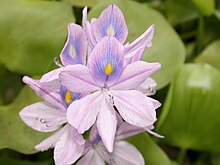Eichhornia
| Water hyacinth | |
|---|---|
 |
|
| Common water hyacinth (Eichhornia crassipes) | |
| Scientific classification | |
| Kingdom: | Plantae |
| (unranked): | Angiosperms |
| (unranked): | Monocots |
| (unranked): | Commelinids |
| Order: | Commelinales |
| Family: | Pontederiaceae |
| Genus: |
Eichhornia Kunth |
| Species | |
|
Seven species (from Tropicos): |
|
Seven species (from Tropicos):
Eichhornia azurea - Anchored water hyacinth
Eichhornia crassipes - Common water hyacinth
Eichhornia diversifolia - Variableleaf water hyacinth
Eichhornia heterosperma
Eichhornia natans
Eichhornia paniculata - Brazilian water hyacinth
Eichhornia paradoxa
Eichhornia, water hyacinth, is a genus of aquatic flowering plants in the family Pontederiaceae. The genus is native to South America. E. crassipes has become widely naturalized in tropical and subtropical regions and is a significant invasive species.
Eichhornia species are perennial aquatic plants (or hydrophytes) native to tropical and sub-tropical South America, excepting E. natans from Africa. An erect stalk supports a single spike of up to 30 conspicuously attractive flowers, mostly lavender to pink in colour with six petals. When not in bloom, water hyacinth may be mistaken for frog's-bit (Limnobium spongia). The common water hyacinth (Eichhornia crassipes) are vigorous growers known to double their population in two weeks.
Water hyacinth has been widely introduced in North America, Asia, Australia, Africa and New Zealand. They can be found in large water areas such as Louisiana, or in the Kerala Backwaters in India. In many areas it, particularly E. crassipes, is an important and pernicious invasive species. First introduced to North America in 1884, an estimated 50 kilograms per square metre of hyacinth once choked Florida's waterways, although the problem there has since been mitigated. When not controlled, water hyacinth will cover lakes and ponds entirely; this dramatically impacts water flow, blocks sunlight from reaching native aquatic plants, and starves the water of oxygen, often killing fish (or turtles). The plants also create a prime habitat for mosquitos, the classic vectors of disease, and a species of snail known to host a parasitic flatworm which causes schistosomiasis (snail fever). Directly blamed for starving subsistence farmers in Papua New Guinea, water hyacinth remains a major problem where effective control programs are not in place. Water hyacinth is often problematic in man-made ponds if uncontrolled, but can also provide a food source for gold fish, keep water clean and help to provide oxygen to man-made ponds.
...
Wikipedia
